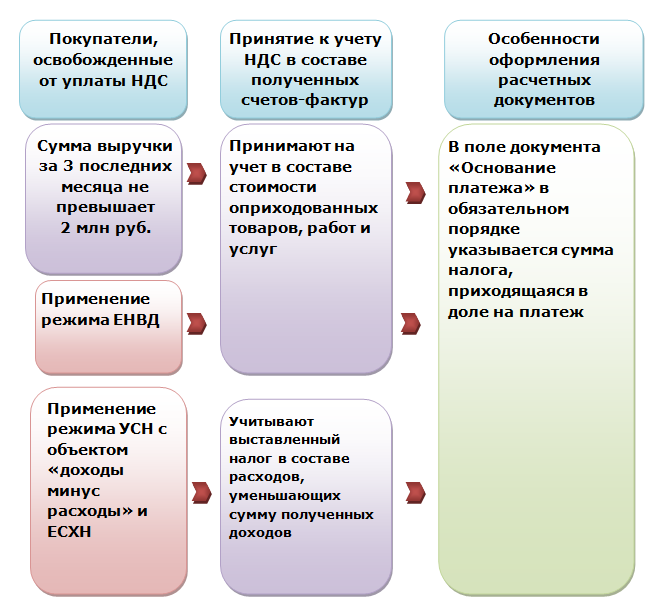The organization operates without VAT, interacting with the organization that is the payer of this tax. The situation is not uncommon. Let's consider the basic rules for documenting transactions between such companies and the features of accepting goods (works, services) for accounting, as well as VAT for each party.
The seller does not pay VAT
When an organization operates without VAT, it draws up a contract, an invoice for payment and shipping documents addressed to the buyer (invoice or act) without indicating the amount of VAT. In the appropriate places, either a dash or the entry “Excluding tax (VAT)” is placed. In the text of the contract, invoice or in a free-form letter, it is recommended to indicate the reason why the seller does not pay VAT.
Organizations using exemption from VAT payer obligations under Articles 145 (based on revenue volume) and 145.1 (participant of the Skolkovo project) of the Tax Code of the Russian Federation must, upon shipment, draw up a sales invoice using the entry “Without tax (VAT)” in the corresponding column document (clause 5 of article 168 of the Tax Code of the Russian Federation).
For those who plan to apply VAT exemption, We recommend that you read the material .
Organizations that apply special tax regimes (Unified Agricultural Tax, simplified tax system or UTII) are not VAT payers and are not required to issue an invoice (clause 3 of article 169 of the Tax Code of the Russian Federation). Also, organizations that carry out transactions that are not subject to VAT in accordance with Art. 149 of the Tax Code of the Russian Federation (subparagraph 1, clause 3, Article 169 of the Tax Code of the Russian Federation). If these organizations decide to issue such a document, then it is recommended to draw it up similarly to the requirements given in paragraph 5 of Art. 168 Tax Code of the Russian Federation.
The buyer, who is a VAT payer, upon receipt of documents from an organization operating without VAT, takes into account goods (work, services) at their cost indicated in the documents. The VAT that is missing from the seller’s documents is not taken into account by the buyer and is not calculated additionally.
In documents for payment to a seller working without VAT, the “Base of payment” field must contain the entry “Without tax (VAT).”
The buyer does not pay VAT
When the supplier of an organization that operates without VAT is an organization that pays VAT, the contract, invoice for payment and shipping documents addressed to the buyer (invoice or act) are drawn up with VAT. In the corresponding columns and places in the text of the documents, the tax rates and amounts that form the total total amount of the document are indicated.
The VAT payer, obliged in accordance with clause 3 of Art. 169 of the Tax Code of the Russian Federation, upon sale, draw up an invoice; with the written consent of the parties to the transaction, this document may not be drawn up for taxpayers working without VAT (subclause 1, clause 3, article 169 of the Tax Code of the Russian Federation).
Will help you obtain consent for non-drawing of invoices our material .
In this case, the VAT payer must reflect in the sales book either the details of the primary documents or the details of the invoice issued for himself in a single copy. Failure to perform these actions will result in an understatement of the amount of VAT on sales.
If the organization purchasing goods (works, services) operates without VAT, then it takes into account the tax highlighted in the documents of the supplier working with VAT in one of the following ways:
- In full, when accepted for accounting, it is included in the cost of these goods (works, services) at a time, according to subparagraph. 3 p. 2 art. 170 Tax Code of the Russian Federation. This method is used by organizations that use the exemption from VAT payer obligations under Art. 145 and 145.1 of the Tax Code of the Russian Federation, as well as organizations located on UTII (taking into account the provisions of clause 7 of Article 346.26, Chapter 26.3 of the Tax Code of the Russian Federation).
- In a certain order (depending on the type of expenses to which the tax relates and the fact of their payment) it is included in expenses that reduce income. This method is used when using the simplified tax system with the object of taxation “income minus expenses” and the unified agricultural tax (subclause 8, clause 2, article 346.5, chapter 26.1 and subclause 8, clause 1, article 346.16, chapter 26.2 of the Tax Code of the Russian Federation).

In documents for payment to a supplier working with VAT, in the “Base of payment” field, the buyer who does not pay VAT must highlight the amount of VAT that is part of this payment.
A supplier working with VAT, upon receiving an advance payment from a buyer who does not pay VAT for upcoming supplies, in the usual manner for a VAT payer, issues an invoice for the received advance in one copy. A buyer who does not pay VAT does not need an advance invoice issued by the supplier.
Results
A seller who does not pay VAT or is exempt from paying tax is not required to issue invoices. A buyer who is a defaulter or exempt from paying VAT takes into account input tax depending on the tax system he has adopted.
